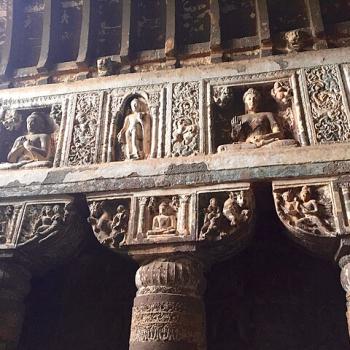 The Zen way has proven to be the cleanest path toward depth I’ve stumbled upon in the course of my life. It is the essence of practical mysticism, providing clear pointers to the goal of nondual experience, simple precepts for maintaining a harmonious life, and with shikantaza and koans provides two of the most effective spiritual disciplines I’ve ever found.
The Zen way has proven to be the cleanest path toward depth I’ve stumbled upon in the course of my life. It is the essence of practical mysticism, providing clear pointers to the goal of nondual experience, simple precepts for maintaining a harmonious life, and with shikantaza and koans provides two of the most effective spiritual disciplines I’ve ever found.
And the Zen way has numerous problematic elements.
I suspect that the foremost of these problematic elements is the Zen teacher.
Now, I think guides upon the great way are of incredible importance, for most of us probably essential. Linji famously warned, “If you meet the Buddha on the road, kill him.” He wasn’t actually talking about the great teacher you encounter on your way to Boston, but the “buddha” that calls himself, calls herself “me.” The worst teacher, the one most inclined to abuse of sex or power or, well that list is very, very long, is the one inside our skulls. Sadly, that monster is very seductive and whispers enticements all the time…
So, we need teachers, most all of us, people who know us, who understand the traps, and guide us toward our own experience. We need people who can say, “You know, that’s probably not so…” At least that’s my observation. And, I believe, the Zen path has created a pretty good school of spiritual direction. And, I hope, I’m underscoring, teachers have proven to be pretty important…
Sadly, the mythic structures of Zen have overstated what a teacher is, implying and sometimes stating straight out that once awakened somehow everything the Zen teacher does is a pointer on the way. Here’s a little truth statement: It isn’t so… Both students and teachers have been misled by this romance and have found themselves over their heads in the weeds. Too often…
But, as I’ve suggested, nonetheless, we need teachers, we need guides, we need friends who have walked the way before us. I believe we need to reframe the teacher a little, take her down a peg, let him be a little more human and a lot more fallible. And from there take a little more personal responsibility.
One possibly useful way to get a handle on this is to look to the differences between the understanding of Catholic and Anglican priesthoods. The former creates a story of grand and magical proportions where the priest stands in a line of contact that traces back to Jesus himself. Unbroken and containing charisms that give life eternal. The Anglican, for the most part, view takes the same story and sees it as a useful myth. I think Zen teachers and practitioners would both be much better off holding the teacher just as lightly as the wisest Anglicans hold their priesthood…
The second problematic issue is how we hold the practices themselves. I’ve written of koans elsewhere. And no doubt will return to that subject. Here I’m thinking of shikantaza, “just sitting,” or “silent illumination.”
Bottom line the practice is “sit down, shut up and pay attention.”
I believe from the depths of my being this is the universal solvent. It is the gateway to genuine wisdom.
And, sadly this practice is constantly fetishized within Zen circles.
Some people, including the masters of old, have gotten off the track and make the practice about posture. Here’s another little hint on the way: one need not overly worry about posture. Following the traditional guidelines is good, but, here’s the bottom line: not necessary.
Sit down, shut up and pay attention.
Need a commentary on this? Consistent and regular practice and occasional retreats are the ideal rhythm of practice.
If you can’t sit down, well just shut up and pay attention. That’s enough. Really…
And, if you can’t sit down or shut up, well, it’s going to be harder, but still: pay attention.
And, you know, it’ll turn out that’s enough.
One of my Western spiritual guides Henry David Thoreau had a thought or two on this subject, written long before anyone in the West had heard of shikantaza or got tangled in literalist interpretations of what it was about.
“We must learn to reawaken and keep ourselves awake, not by mechanical aids, but by an infinite expectation of the dawn, which does not forsake us even in our soundest sleep. I know of no more encouraging fact than the unquestionable ability of man to elevate his life by a conscious endeavour. It is something to be able to paint a particular picture, or to carve a statue, and so to make a few objects beautiful; but it is far more glorious to carve and paint the very atmosphere and medium through which we look, which morally we can do. To affect the quality of the day, that is the highest of arts.”
So, my encouraging words this morning.
Pay attention.
That’s enough…












